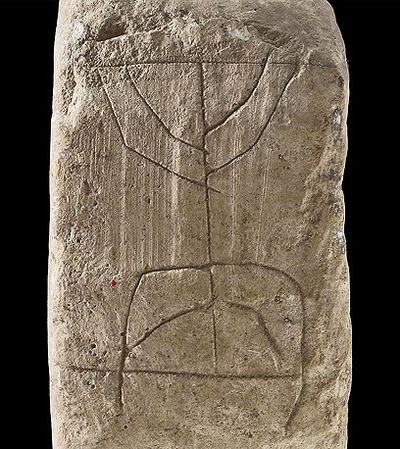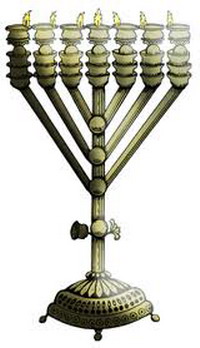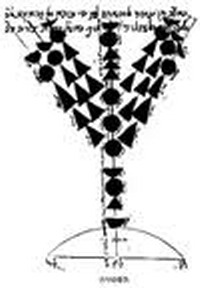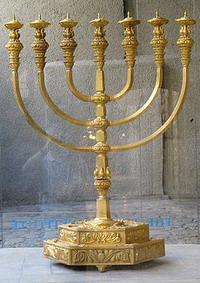BHR-74
Brit-Am Historical Reports
11 August 2011 11 Av 5771
Contents:
1. The influence of sheep on Tree-Rings!
2. Brit-Am Version of Explorator 14.15
3. New Finds in Jerusalem
2,000 Year Old Sword, Menorah 'Sketch' Found
4. More Menorah Pictures.
5. Discovery of ancient cave paintings in Petra stuns art scholars
|
Brit-Am Discussion Group |
Contents by Subject |
Research Recognition Reconciliation Contribute |
|
Site Map Contents in Alphabetical Order |
This Site |
1. The influence of sheep on Tree-Rings!
Seeing the wood for the trees: New study shows sheep in tree-ring records
[Could this influence chronological dating by Tree-Rings?]
http://www.eurekalert.org/pub_releases/2011-07/w-stw072511.php
Nibbling by herbivores can have a greater impact on the width of tree rings than climate, new research has found. The study, published this week in the British Ecological Society's journal Functional Ecology, could help increase the accuracy of the tree ring record as a way of estimating past climatic conditions.
Many factors in addition to climate are known to affect the tree ring record, including attack from parasites and herbivores, but determining how important these other factors have been in the past is difficult.
Working high in the mountains of southern Norway, midway between Oslo and Bergen, a team from Norway and Scotland fenced off a large area of mountainside and divided it into different sections into each of which a set density of domestic sheep was released every summer.
After nine summers, cross sections of 206 birch trees were taken and tree ring widths were measured. Comparing these with local temperature and the numbers of sheep at the location where the tree was growing allowed the team to disentangle the relationship between temperature and browsing by sheep and the width of tree rings.
According to lead author Dr James Speed of the NTNU Museum of Natural History and Archaeology: "We found tree ring widths were more affected by sheep than the ambient temperature at the site, although temperatures were still visible in the tree ring records. This shows that the density of herbivores affects the tree ring record, at least in places with slow-growing trees."
The impact of large herbivores on tree rings has, until now, been largely unknown, so these findings could help increase the accuracy of the tree ring record as a way of estimating past climatic conditions, says Dr Speed: "Our study highlights that other factors interact with climate to affect tree rings, and that to increase the accuracy of the tree ring record to estimate past climatic conditions, you need to take into account the history of wild and domestic herbivores. The good news is that past densities of herbivores can be estimated from historic records, and from the fossilised remains of spores from fungi that live on dung."
"This study does not mean that using tree rings to infer past climate is flawed as we can still see the effect of temperatures on the rings, and in lowland regions tree rings are less likely to have been affected by herbivores because they can grow out of reach faster," he explains.
Tree rings give us a window into the past, and have been widely used as climate recorders since the early 1900s. The growth rings are visible in tree trunk cross sections, and are formed in seasonal environments as the wood is laid down faster in summer than winter. In years with better growing conditions (in cool locations this usually means warmer) tree rings are wider, and because trees can be very long-lived and wood is easily preserved, for example in bogs and lakes, this allows very long time-series to be established, and climatic conditions to be estimated from the ring widths.
###
The study was funded by the Norwegian Research Council and the Norwegian Directorate for Nature Management.
James D. M. Speed, Gunnar Austrheim, Alison J. Hester and Atle Mysterud (2011), 'Browsing interacts with climate to determine tree ring increment', doi: 10.1111/j.1365-2435.2011.01877.x, is published in Functional Ecology on 27 July 2011.
2. Brit-Am Version of Explorator 14.15
From: david meadows <rogueclassicist@gmail.com>
================================================================
ANCIENT NEAR EAST AND EGYPT
================================================================
On the "serious weaponry" wielded by ancient Egyptian royalty:
http://www.foxnews.com/scitech/2011/07/25/ancient-egyptian-royalty-wielded-serious-weapons/
http://www.cbsnews.com/stories/2011/07/25/scitech/main20082924.shtml
A 3000 years b.p. altar from Tel Tzafit:
http://www.haaretz.com/print-edition/news/3-000-year-old-altar-uncovered-at-philistine-site-suggests-cultural-links-to-jews-1.375305
Bronze Age burials from Terqa:
http://content.usatoday.com/communities/sciencefair/post/2011/07/tough-times-reported-for-ancient-warrior/1
A 3000 years b.p. stone altar from Tel Tzafit (Gat):
http://www.foundationstone.org/ (with links to audio)
http://www.haaretz.com/print-edition/news/3-000-year-old-altar-uncovered-at-philistine-site-suggests-cultural-links-to-jews-1.375305
http://www1.biu.ac.il/indexE.php?id=33&pt=20&pid=117&level=2&cPath=33&type=1&news=1471
... see also Aren Maeir's blog posts on same:
http://gath.wordpress.com/2011/07/25/the-news-is-out-a-large-stone-altar-in-area-d/
http://gath.wordpress.com/2011/07/26/the-altar-is-out-and-a-possible-inscription/
http://gath.wordpress.com/2011/07/27/removing-the-altar-from-area-d/
http://gath.wordpress.com/2011/07/27/short-clip-explaining-about-the-altar/
http://gath.wordpress.com/2011/07/27/inscription/
A 2800 years b.p. lion statue from Tell Tayinat:
http://www.unreportedheritagenews.com/2011/07/2800-year-old-lion-statue-discovered-at.html
A Dead Sea Scroll was a 'precursor' to the Jewish calendar:
http://www.manchester.ac.uk/aboutus/news/display/?id=7274
https://www.escholar.manchester.ac.uk/api/datastream?publicationPid=uk-ac-man-scw:128116&datastreamId=FULL-TEXT.PDF
... perhaps you want to adopt your own DSS:
http://www.dailymail.co.uk/news/article-2020595/
The clash between politics and archaeology continues in Jerusalem:
http://www.haaretz.com/print-edition/news/knesset-legislation-gives-right-wing-group-control-over-city-of-david-park-1.375645
http://www.haaretz.com/news/national/government-move-would-cement-rightist-group-s-control-of-jerusalem-national-park-1.375546
More on that bell from Jerusalem's Old City:
http://www.artdaily.org/index.asp?int_sec=2&int_new=49345
http://www.mfa.gov.il/MFA/History/Early+History+-+Archaeology/Gold_bell_excavations_Jerusalem_24-Jul-2011.htm
http://www.postchronicle.com/news/original/2000_Year_Old_Bell_20110727.shtml
http://www.dawn.com/2011/07/22/tiny-2000-year-old-golden-bell-found-in-jerusalem.html
http://www.denverpost.com/nationworld/ci_18542433
http://au.news.yahoo.com/thewest/a/-/world/9907921/ancient-bell-found-in-jerusalem-sewer/
http://www.stuff.co.nz/world/middle-east/5336971/Ancient-bell-found-in-Jerusalem-Old-City-sewer
http://www.stamfordadvocate.com/news/article/In-Jerusalem-a-2-000-year-old-bell-rings-again-1567355.php
http://www.jta.org/news/article/2011/07/24/3088678/in-jerusalem-a-peal-from-the-past
... and if you want to hear it ring:
http://www.youtube.com/watch?v=xjx9tP3yTRI
http://www.imra.org.il/story.php3?id=53224
More on Tell Balata:
http://www.jpost.com/NationalNews/Article.aspx?id=230833
http://english.alarabiya.net/articles/2011/07/23/159004.html
Dr Leen Ritmeyer's Blog:
http://blog.ritmeyer.com/
Paleojudaica:
http://paleojudaica.blogspot.com/
================================================================
ANCIENT GREECE AND ROME (AND CLASSICS)
================================================================
Visit our blog:
http://rogueclassicism.com/
================================================================
EUROPE AND THE UK (+ Ireland)
================================================================
Possibly the UK's oldest rock art (from Wales):
http://www.physorg.com/news/2011-07-archaeologists-chance-discovery-britain-earliest.html
http://www.upi.com/Science_News/2011/07/25/Cave-art-could-be-Britains-oldest/UPI-79031311632355/
http://www.bristol.ac.uk/news/2011/7812.html
http://www.bbc.co.uk/news/uk-wales-south-west-wales-14272126
I couldn't find any English coverage of this incredibly unique tomb
find from Bosnia-Herzegovina:
http://www.ilmeridiano.net/index.php?option=com_content&view=article&id=4818:sensazionale-scoperta-archeologica-in-bosnia-erzegovina-una-tipologia-di-tomba-mai-vista-prima-&catid=114:cultura&Itemid=540
================================================================
ASIA AND THE SOUTH PACIFIC
================================================================
On the antiquity of the Korean surname 'Kim':
http://www.physorg.com/news/2011-07-common-korean-surname-tale-nationhood.html
================================================================
NORTH AMERICA
================================================================
Using GIS to map out Civil War sites:
http://www.nytimes.com/2011/07/27/arts/geographic-information-systems-help-scholars-see-history.html
================================================================
OTHER ITEMS OF INTEREST
================================================================
Humans living at higher latitudes have larger skulls:
http://www.bbc.co.uk/news/science-environment-14279729
On the various factors that can affect tree ring records:
http://www.eurekalert.org/pub_releases/2011-07/w-stw072511.php
3. New Finds in Jerusalem
2,000 Year Old Sword, Menorah 'Sketch' Found
More Menorah Pictures.
http://www.israelnationalnews.com/News/News.aspx/146499
Stone slab with five-branched menorah etching, Roman era sword discovered near Temple Mount.
by Gil Ronen
Published: 08/08/11, 1:35 PM
|
Exciting finds, including an intact Roman era sword and a stone "sketch" engraving of the Menorah, have been discovered in archeological digs near the Temple Mount recently, and the Antiquities Authority is making them known for Tisha B'Av, the anniversary of the Temple's destruction.
The Authority has been digging, with assistance from the Parks and Gardens Authority and the sponsorship of the NGO Elad, in the ancient drainage canal that served Jerusalem. This ditch runs from the Shiloach (Siloam) Pool to the archeological garden near the Kotel.
Inside the canal, where Jerusalemites hid from the Romans during the siege of the Second Temple, a 2,000-year-old iron sword was found. The sword was inside a leather scabbard. Parts of the belt that carried the scabbard were also found.
Eli Shukrun and Ronny Reich, who are in charge of the digs, said that the sword "may have belonged to a Roman infantryman who was stationed in Jerusalem when the Great Rebellion broke out in 66 CE."
"The sword is surprisingly well-preserved: not just in terms of length, about 60 cm. but also in the preservation of the leather scabbard, and some of its decorations."
At the side of the canal, a stone tablet was found with a rare etching of the golden Menorah that was a central item in the Jewish Temple. ... The sketch describes a five-branched menorah, while the Temple Menorah had seven branches.
4. More Menora Pictures.
|
|
| ||
| |||
|
|
||
5. Discovery of ancient cave paintings in Petra stuns art scholars
http://www.guardian.co.uk/science/2010/aug/22/hellenistic-wall-paintings-petra#start-of-comments
|
Extracts:
Exquisite artworks hidden under 2,000 years of soot and grime in a Jordanian cave have been restored by experts from the Courtauld Institute in London
Spectacular 2,000-year-old Hellenistic-style wall paintings have been revealed at the world heritage site of Petra through the expertise of British conservation specialists. The paintings, in a cave complex, had been obscured by centuries of black soot, smoke and greasy substances, as well as graffiti.
Experts from the Courtauld Institute in London have now removed the black grime, uncovering paintings whose "exceptional" artistic quality and sheer beauty are said to be superior even to some of the better Roman paintings at Herculaneum that were inspired by Hellenistic art.
Virtually no Hellenistic paintings survive today, and fragments only hint at antiquity's lost masterpieces, while revealing little about their colours and composition, so the revelation of these wall paintings in Jordan is all the more significant. They were created by the Nabataeans, who traded extensively with the Greek, Roman and Egyptian empires and whose dominion once stretched from Damascus to the Red Sea, and from Sinai to the Arabian desert.
Such is the naturalistic intricacy of these paintings that the actual species of flowers, birds and insects bursting with life can be identified. They were probably painted in the first century, but may go back further. Professor David Park, an eminent wall paintings expert at the Courtauld, said that the paintings "should make jaws drop".
At the instigation of the Petra National Trust (PNT), conservation experts Stephen Rickerby and Lisa Shekede restored the paintings to life. The work took three years, and was completed only last week.
Petra, the Greek word for "rock", is one of the world's most famous archaeological sites, where ancient eastern traditions combine with Hellenistic architecture, with monumental buildings sculpted out of the solid red sandstone. A Unesco world heritage site since 1985, it was the Nabataeans' capital city, flourishing as an economic and religious centre from the third century BC for some 400 years. Its site, in the Shera mountains, was an important crossroads for Arabia, Egypt and Syria-Phoenicia.
The paintings are not at the main site, but at the less well known canyon of Siq al-Barid in Beidha, nicknamed "Little Petra", about 5km away. As they are now the most important surviving examples of Nabataean art, they rank among Petra's most remarkable treasures and are likely to become a major tourist attraction, Rickerby said. They are located within the "biclinium" (dining area), a principal chamber and a recess, where ritual dining is thought to have taken place. The most outstanding painting covers the vault and the walls of the recess.
The site was a retreat for affluent Nabataeans. The surrounding land shows evidence of ancient vineyards and grape-pressing sites, which explains the significance of the paintings' subject-matter. The Greek historian Strabo conveyed a sense of their wealth when he wrote: "The Nabataeans are a sensible people, and are so much inclined to acquire possessions that they publicly fine anyone who has diminished his possessions."
Rickerby said: "They show a lot of external influences from the ancient world and are as good as, or better than, some of the Roman paintings you see, for example at Herculaneum, This has immense art-historical importance, reflecting a synthesis of Hellenistic-Roman cultural influences."
"It provides an incredibly rare insight into the lifestyle of this ancient and little-known civilisation."
THE NABATAEANS
Few Nabataean manuscripts survive, but it is through the ancient historians Strabo, Josephus and Diodorus that we know something about them and their culture. Diodorus wrote of a people with diverse characteristics who were "exceptionally fond of freedom". Strabo described them as "exceedingly well-governed", with few slaves, banquets with girl singers and "drinking bouts in magnificent style" held by the king, in which "no one drinks more than 11 cupfuls, each time using a different golden cup".
The Nabataeans were among the most successful merchants of their day, trading in spices, medicines, frankincense, precious jewels and metals. Exotic goods were brought by ship to ports in southern Arabia from India and the far east and taken overland to the Mediterranean. Accusations of a monopoly on many of their goods, brought complaints from the Egyptians, Greeks and Romans when they hiked up their prices.
They first appeared to history in 312BC in a cuneiform inscription, recording their defeat of a Syrian army. Although originally a nomadic people of ancient Arabia, they built the spectacular city of Petra as their capital. Such was its fame in antiquity that it was mentioned in Chinese records, as well as those of ancient Greece, Egypt, Rome and Byzantium. It boasted magnificent buildings and carved facades and piped water throughout the city.

Pleased with what you have read?
Click Here to make an offering. |
'It is impossible to rightly govern the world without God or the Bible.'
George Washington
Brit-Am is the "still small voice" that contains the truth.
[1-Kings 19:12] AND AFTER THE EARTHQUAKE A FIRE; BUT THE LORD WAS NOT IN THE FIRE: AND AFTER THE FIRE A STILL SMALL VOICE.
 |
 |








